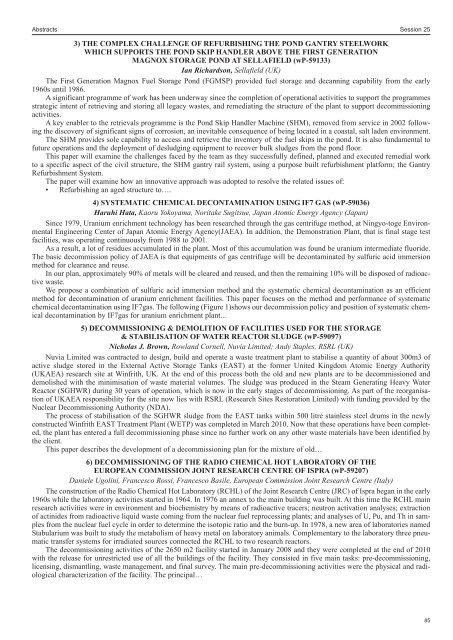ICEM11 Final Program 9.7.11pm_ICEM07 Final Program ... - Events
ICEM11 Final Program 9.7.11pm_ICEM07 Final Program ... - Events
ICEM11 Final Program 9.7.11pm_ICEM07 Final Program ... - Events
You also want an ePaper? Increase the reach of your titles
YUMPU automatically turns print PDFs into web optimized ePapers that Google loves.
Abstracts Session 25<br />
3) THE COMPLEX CHALLENGE OF REFURBISHING THE POND GANTRY STEELWORK<br />
WHICH SUPPORTS THE POND SKIP HANDLER ABOVE THE FIRST GENERATION<br />
MAGNOX STORAGE POND AT SELLAFIELD (wP-59133)<br />
Ian Richardson, Sellafield (UK)<br />
The First Generation Magnox Fuel Storage Pond (FGMSP) provided fuel storage and decanning capability from the early<br />
1960s until 1986.<br />
A significant programme of work has been underway since the completion of operational activities to support the programmes<br />
strategic intent of retrieving and storing all legacy wastes, and remediating the structure of the plant to support decommissioning<br />
activities.<br />
A key enabler to the retrievals programme is the Pond Skip Handler Machine (SHM), removed from service in 2002 following<br />
the discovery of significant signs of corrosion, an inevitable consequence of being located in a coastal, salt laden environment.<br />
The SHM provides sole capability to access and retrieve the inventory of the fuel skips in the pond. It is also fundamental to<br />
future operations and the deployment of desludging equipment to recover bulk sludges from the pond floor.<br />
This paper will examine the challenges faced by the team as they successfully defined, planned and executed remedial work<br />
to a specific aspect of the civil structure, the SHM gantry rail system, using a purpose built refurbishment platform; the Gantry<br />
Refurbishment System.<br />
The paper will examine how an innovative approach was adopted to resolve the related issues of:<br />
• Refurbishing an aged structure to….<br />
4) SYSTEMATIC CHEMICAL DECONTAMINATION USING IF7 GAS (wP-59036)<br />
Haruhi Hata, Kaoru Yokoyama, Noritake Sugitsue, Japan Atomic Energy Agency (Japan)<br />
Since 1979, Uranium enrichment technology has been researched through the gas centrifuge method, at Ningyo-toge Environmental<br />
Engineering Center of Japan Atomic Energy Agency(JAEA). In addition, the Demonstration Plant, that is final stage test<br />
facilities, was operating continuously from 1988 to 2001.<br />
As a result, a lot of residues accumulated in the plant. Most of this accumulation was found be uranium intermediate fluoride.<br />
The basic decommission policy of JAEA is that equipments of gas centrifuge will be decontaminated by sulfuric acid immersion<br />
method for clearance and reuse.<br />
In our plan, approximately 90% of metals will be cleared and reused, and then the remaining 10% will be disposed of radioactive<br />
waste.<br />
We propose a combination of sulfuric acid immersion method and the systematic chemical decontamination as an efficient<br />
method for decontamination of uranium enrichment facilities. This paper focuses on the method and performance of systematic<br />
chemical decontamination using IF7gas. The following (Figure 1)shows our decommission policy and position of systematic chemical<br />
decontamination by IF7gas for uranium enrichment plant...<br />
5) DECOMMISSIONING & DEMOLITION OF FACILITIES USED FOR THE STORAGE<br />
& STABILISATION OF WATER REACTOR SLUDGE (wP-59097)<br />
Nicholas J. Brown, Rowland Cornell, Nuvia Limited; Andy Staples, RSRL (UK)<br />
Nuvia Limited was contracted to design, build and operate a waste treatment plant to stabilise a quantity of about 300m3 of<br />
active sludge stored in the External Active Storage Tanks (EAST) at the former United Kingdom Atomic Energy Authority<br />
(UKAEA) research site at Winfrith, UK. At the end of this process both the old and new plants are to be decommissioned and<br />
demolished with the minimisation of waste material volumes. The sludge was produced in the Steam Generating Heavy Water<br />
Reactor (SGHWR) during 30 years of operation, which is now in the early stages of decommissioning. As part of the reorganisation<br />
of UKAEA responsibility for the site now lies with RSRL (Research Sites Restoration Limited) with funding provided by the<br />
Nuclear Decommissioning Authority (NDA).<br />
The process of stabilisation of the SGHWR sludge from the EAST tanks within 500 litre stainless steel drums in the newly<br />
constructed Winfrith EAST Treatment Plant (WETP) was completed in March 2010. Now that these operations have been completed,<br />
the plant has entered a full decommissioning phase since no further work on any other waste materials have been identified by<br />
the client.<br />
This paper describes the development of a decommissioning plan for the mixture of old…<br />
6) DECOMMISSIONING OF THE RADIO CHEMICAL HOT LABORATORY OF THE<br />
EUROPEAN COMMISSION JOINT RESEARCH CENTRE OF ISPRA (wP-59207)<br />
Daniele Ugolini, Francesco Rossi, Francesco Basile, European Commission Joint Research Centre (Italy)<br />
The construction of the Radio Chemical Hot Laboratory (RCHL) of the Joint Research Centre (JRC) of Ispra began in the early<br />
1960s while the laboratory activities started in 1964. In 1976 an annex to the main building was built. At this time the RCHL main<br />
research activities were in environment and biochemistry by means of radioactive tracers; neutron activation analyses; extraction<br />
of actinides from radioactive liquid waste coming from the nuclear fuel reprocessing plants; and analyses of U, Pu, and Th in samples<br />
from the nuclear fuel cycle in order to determine the isotopic ratio and the burn-up. In 1978, a new area of laboratories named<br />
Stabularium was built to study the metabolism of heavy metal on laboratory animals. Complementary to the laboratory three pneumatic<br />
transfer systems for irradiated sources connected the RCHL to two research reactors.<br />
The decommissioning activities of the 2650 m2 facility started in January 2008 and they were completed at the end of 2010<br />
with the release for unrestricted use of all the buildings of the facility. They consisted in five main tasks: pre-decommissioning,<br />
licensing, dismantling, waste management, and final survey. The main pre-decommissioning activities were the physical and radiological<br />
characterization of the facility. The principal…<br />
85
















